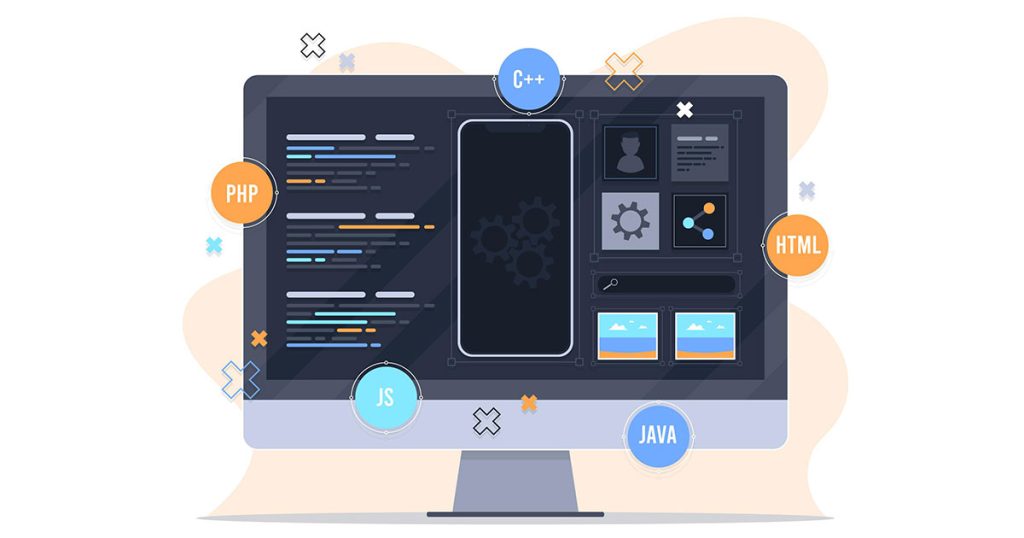What is Software Development?

Introduction to Software Development
Software development is a crucial aspect of the modern world, driving technological advancements and enabling innovative solutions to everyday problems. It involves the process of designing, creating, testing, and maintaining computer programs and applications. Software developers play a key role in this process, utilizing their coding skills and expertise to develop software that meets specific requirements and goals. They collaborate with a diverse team of professionals, including designers, project managers, and stakeholders, to ensure the successful execution of software projects. Software development follows a structured process that includes requirements gathering, design, programming, testing, and deployment. It requires continuous learning and adaptation to keep up with evolving technologies and user needs. Overall, software development is essential for improving efficiency, enabling global connectivity, and driving technological innovation across various industries.
What is software development?
Software development is the process of designing, creating, testing, and maintaining computer programs and applications. It involves the use of various programming languages and tools to write code and instructions that tell computers what to do. Software development follows a structured lifecycle, starting with gathering requirements and analyzing user needs. The design phase involves creating a blueprint for the software’s architecture and functionality. Then, programmers write the code and test it to ensure it functions as intended. Once the software is deployed, developers continue to maintain and update it to address any issues or add new features. Software development is essential for creating innovative solutions, improving efficiency, and driving technological advancements in various industries.
Importance of software development in today’s world
Software development plays a crucial role in today’s world as it drives innovation, enhances efficiency, and improves the overall user experience. In a technology-driven society, software applications and systems have become an integral part of our daily lives, whether it’s communication, entertainment, or business operations.
The importance of software development lies in its ability to meet the evolving needs of individuals and businesses. With the increasing reliance on smartphones and other digital devices, software developers create user-friendly applications that offer convenience and accessibility. Additionally, software development enables businesses to streamline their operations, automate processes, and gather valuable data for informed decision-making.

Furthermore, software development contributes to technological advancements, such as artificial intelligence and machine learning, which have transformative implications across various industries. It empowers organizations to stay competitive, adapt to market demands, and provide innovative solutions to their customers. Overall, software development drives progress and enables the continuous evolution of our digital world.
Phases of Software Development
Software development follows a series of phases to ensure a systematic and organized approach.
The first phase is requirements gathering and analysis, where developers gather information about the desired software functionality and user needs. This phase sets the foundation for the subsequent stages and helps in creating a clear project scope.
Next comes the design and prototyping phase, where the software’s architecture, user interface, and overall structure are defined. This phase includes creating wireframes, prototypes, and system models to visualize the software’s design.
After the design phase, developers move on to the actual coding and development, where they write the code and implement the designed features. This is followed by extensive testing to detect and fix any bugs or errors.
Finally, the software is deployed, and maintenance and updates are carried out to ensure its smooth functioning and address any issues that arise. Proper documentation is also essential throughout the entire software development process.
Requirements gathering and analysis
Requirements gathering and analysis is a crucial phase in software development. It involves gathering information about the desired functionality of the software and the needs of the users. This phase sets the foundation for the entire development process and helps in creating a clear project scope.
During requirements gathering, developers interact with stakeholders, conduct interviews, and analyze documentation to understand the objectives and constraints of the project. They identify the features, functionalities, and performance requirements that the software should meet.
Requirements analysis involves evaluating the gathered information, identifying any inconsistencies or conflicts, and prioritizing the requirements. This helps in creating a comprehensive and accurate set of requirements that will guide the development process. Effective requirements gathering and analysis ensure that the software developed aligns with the needs and expectations of the users.
Design and prototyping
Design and prototyping is a crucial phase in software development that focuses on creating a visual representation of the software’s user interface and functionality. During this phase, designers and developers work together to design the layout, navigation, and overall user experience of the software. Prototypes, or mockups, are created to provide a tangible representation of the software’s design.
The purpose of design and prototyping is to gather feedback from stakeholders and end-users before development begins. This helps identify any potential design flaws or usability issues early on, allowing for adjustments to be made before investing time and resources into coding. Design and prototyping also help ensure that the software meets the desired aesthetic and functional requirements.
Overall, design and prototyping play a crucial role in creating user-friendly, visually appealing, and efficient software applications.

Programming Languages and Tools
Programming Languages and Tools: Programming languages are essential tools in software development that allow developers to write instructions and commands for computers to execute tasks. Some popular programming languages used in software development include Python, JavaScript, Java, C++, and Ruby. Each language has its syntax and features, making it suitable for different types of projects.
In addition to programming languages, developers also rely on various tools to enhance their productivity and efficiency. Integrated Development Environments (IDEs) like Visual Studio Code, Eclipse, and PyCharm provide a comprehensive development environment with tools for code editing, debugging, and version control. Other tools like Git, JIRA, and Slack enable collaboration and project management.
Choosing the right programming language and tools depends on factors such as project requirements, scalability, and developer expertise. Constantly learning new languages and staying updated with the latest tools is crucial for software developers to adapt to evolving technologies and industry trends.
Popular programming languages for software development
For software development, there are several popular programming languages that developers use to write code. Python is a versatile language known for its simplicity and readability. It is widely used for web development, data analysis, and artificial intelligence. JavaScript is another widely used language, primarily for web development and creating dynamic and interactive websites. Java is a widely adopted language for building enterprise-level applications, particularly in the mobile and banking industries. C++ is a powerful language used for system programming and creating high-performance applications. Ruby is known for its simplicity and elegance, making it popular for web development. These languages, along with others like C#, Swift, and PHP, provide developers with a range of options to choose from based on their project requirements and personal preferences.
Essential tools for software development
In the world of software development, there are several essential tools that developers rely on to create efficient and high-quality applications. These tools help streamline the development process, enhance collaboration, and improve productivity. Some of the key tools include integrated development environments (IDEs) such as Visual Studio, Eclipse, and Xcode, which provide a comprehensive set of features for writing, testing, and debugging code. Version control systems like Git and Subversion enable developers to track changes and collaborate on projects effectively. Build tools like Maven and Gradle to automate the compilation and packaging of code. Additionally, project management tools like Jira and Trello help teams organize tasks, track progress, and coordinate efforts. These tools are essential for modern software development, allowing developers to work efficiently and deliver high-quality software products.
Software Development Methodologies
Software development methodologies refer to the approaches and frameworks used by software development teams to plan, organize, and execute the development process. These methodologies provide a structured and systematic approach to software development, helping teams manage resources, meet deadlines, and deliver high-quality software products. Two commonly used methodologies are Agile and Waterfall.
Agile methodology emphasizes flexibility and adaptive planning, with frequent iterations and continuous collaboration between team members and stakeholders. It allows for quick feedback and adjustments throughout the development process.
Waterfall methodology, on the other hand, follows a sequential approach, with each phase completed before moving on to the next. It emphasizes thorough planning and documentation but may be less flexible in accommodating changes.
Choosing the right methodology depends on factors such as project requirements, team dynamics, and customer expectations. Software development teams need to evaluate and select the most suitable methodology for their specific project to ensure successful outcomes.

Agile methodology and its benefits
Agile methodology is a flexible and collaborative approach to software development. It emphasizes iterative and incremental development, with frequent delivery of working software.
One of the main benefits of Agile methodology is improved adaptability. It allows teams to respond quickly to changes in requirements or customer feedback, enabling them to deliver a product that better meets user needs. Agile also promotes regular collaboration and communication between team members and stakeholders, ensuring that everyone is aligned on project goals and progress.
Another advantage of Agile is increased transparency. The use of user stories and frequent demonstrations of working software enable stakeholders to have a clear understanding of the progress and functionality of the project.
Furthermore, Agile promotes a focus on customer satisfaction. By continuously involving users throughout the development process, Agile ensures that their feedback and preferences are taken into account, resulting in a product that truly meets their needs.
Overall, Agile methodology helps development teams deliver high-quality software in a more flexible, collaborative, and customer-centric manner.
Waterfall methodology and its advantages
The Waterfall methodology is a sequential approach to software development, where each phase is completed before moving on to the next. This method is often favored for projects with well-defined and stable requirements.
Some of the advantages of the Waterfall methodology include:
- Clear structure: The Waterfall model follows a linear and structured process, making it easy to understand and implement.
- Well-defined requirements: The requirements are gathered and defined at the beginning of the project, minimizing changes and scope creep.
- Easy to manage: The sequential nature of the Waterfall model allows for better project management, as it provides a clear plan and timeline.
- Documentation: Each phase in the Waterfall model is well-documented, making it easier to track progress and ensure quality.
- Client involvement: This model allows for early client involvement, as requirements are clearly defined upfront.
However, the Waterfall model has limitations when it comes to adapting to changes and can lead to slower development cycles if requirements change during the process.
Testing and Deployment
Testing and Deployment is a critical phase in the software development process. After the software has been developed, it needs to be thoroughly tested to ensure its functionality and quality. This involves running different test scenarios and checking for any bugs or issues.
Various types of testing can be performed, such as unit testing, integration testing, system testing, and user acceptance testing. Each type of testing focuses on different aspects of the software and helps identify any errors or inconsistencies.
Once the testing phase is complete and the software has passed all the necessary tests, it is ready for deployment. Deployment involves making the software available to users in a production environment. This may involve installing the software on servers, configuring the necessary settings, and ensuring that it is accessible to users.
Importance of testing in software development
Testing plays a crucial role in the software development process. It is essential for ensuring the functionality, performance, and reliability of a software application. Testing helps to uncover any bugs, errors, or issues in the software and allows developers to fix them before the application is deployed to users.
By conducting thorough testing, developers can identify and fix any defects in the code, ensuring that the software meets the requirements and expectations of the end-users. It helps to improve the overall quality of the software and enhances the user experience. Additionally, testing helps to reduce the risk of software failure and ensures that the application performs as intended.
Overall, testing is vital in software development as it helps to deliver a high-quality product that meets user needs and provides a positive user experience.

Strategies for successful deployment
To ensure a successful deployment of software, it is important to follow certain strategies. Firstly, thorough testing should be conducted to identify and fix any issues before deployment. This includes functional testing, performance testing, and user acceptance testing. Additionally, a well-defined deployment plan should be created, outlining the necessary steps and timelines for the deployment process. This plan should also include a rollback strategy in case any issues arise during deployment. Communication is crucial during deployment, and stakeholders should be kept informed about the progress and any potential challenges. It is important to have a dedicated team responsible for the deployment process, ensuring that all necessary tasks are completed efficiently. Regular monitoring and post-deployment support should also be provided to address any issues that may arise.
Future Trends in Software Development
As technology continues to advance at a rapid pace, the field of software development is constantly evolving. Several key trends are shaping the future of software development. One of the major trends is the integration of artificial intelligence (AI) and machine learning (ML) into software applications. AI and ML technologies are being used to enhance the functionality and performance of software, enabling applications to learn, adapt, and make intelligent decisions.
Another important trend is the increasing importance of mobile and cloud technologies in software development. With the proliferation of mobile devices and the growing reliance on cloud computing, developers must focus on creating mobile-friendly and cloud-based applications to meet the demands of users.
Furthermore, the rise of low-code and no-code development platforms is simplifying the software development process and allowing users with limited coding knowledge to create their applications.
Overall, the future of software development promises exciting advancements and innovations as technology continues to evolve. Developers must continually adapt and embrace these trends to stay ahead in this rapidly changing field.
Artificial intelligence and machine learning in software development
Artificial intelligence (AI) and machine learning (ML) have revolutionized the field of software development. These technologies can enhance the functionality and performance of software applications by enabling them to learn, adapt, and make intelligent decisions.
AI and ML algorithms can analyze large sets of data to uncover patterns and make predictions, allowing software to automate complex tasks and improve efficiency. Developers can use these technologies to create intelligent chatbots, personalized recommendation systems, and advanced data analytics tools.
In addition, AI and ML can be used to enhance user experiences by enabling software applications to understand and respond to user inputs more naturally and intuitively. This includes features such as voice recognition, natural language processing, and facial recognition.
Overall, the integration of AI and ML into software development has the potential to open up new possibilities and drive innovation in the industry. Developers must stay up-to-date with these advancements and embrace them to create cutting-edge software solutions.
Impact of mobile and cloud technologies
The rapid advancement of mobile and cloud technologies has had a profound impact on software development. Mobile devices have become an integral part of our daily lives, with millions of applications available for download. This has created a huge demand for mobile app development, leading to new opportunities for software developers. Cloud technologies have also revolutionized the way software is developed and deployed. Cloud platforms provide developers with scalable infrastructure, increased flexibility, and easy access to resources, allowing for faster and more efficient software development. Additionally, cloud-based services enable seamless collaboration among team members, regardless of their geographical location. In general, the merging of mobile and cloud technologies has changed the field of software development, resulting in better user experiences and stronger connectivity.

Conclusion
In conclusion, software development plays a crucial role in shaping our digital world. It encompasses the process of designing, creating, testing, and maintaining software applications. From mobile apps to complex enterprise systems, software development enables technological innovation and improves efficiency in various industries.
Throughout the phases of software development, including requirements gathering, design, programming, testing, and deployment, collaboration and effective communication are essential for success. The use of different methodologies, such as Agile and Waterfall, depends on the project’s specific needs and goals.
As technology continues to advance, software development will continue to evolve. Future trends, such as the integration of artificial intelligence and machine learning, and the impact of mobile and cloud technologies, will shape the future of software development.
Overall, continuous learning and staying updated with the latest developments in software development are crucial for success in this dynamic field.
Summary of key points discussed
In this article, we discussed the concept and importance of software development in today’s world. We explored the different phases of software development, including requirements gathering, design, and programming. We also discussed the popular programming languages and essential tools used in the software development process.
Furthermore, we highlighted the importance of using different software development methodologies, such as Agile and Waterfall, and the significance of testing and deployment in ensuring the quality of software applications.
We also looked into future trends in software development, such as the integration of artificial intelligence and machine learning, as well as the impact of mobile and cloud technologies.
Importance of continuous learning in software development
Continuous learning is of utmost importance in the field of software development. With rapid advancements in technology and ever-evolving programming languages and tools, staying updated and acquiring new skills is crucial for success.
Software developers need to continuously learn and adapt to new technologies, frameworks, and methodologies to stay competitive in the industry. This allows them to develop cutting-edge solutions and meet the changing needs of clients and users. Additionally, continuous learning enables developers to stay ahead of emerging trends such as artificial intelligence, machine learning, and cloud computing.
By engaging in continuous learning, software developers can improve their problem-solving abilities, enhance their understanding of best practices, and stay updated on the latest security measures. It also helps them broaden their skill set and opens up new opportunities for career growth and professional development.





